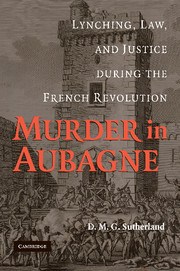Book contents
- Frontmatter
- Contents
- List of Figures
- Preface
- Acknowledgments
- Abbreviations
- Aubagne: An Introduction to the Problem
- 1 Structures and Events
- 2 The Olive Festival
- 3 Aubagne's Universe: Marseille, Aix, and Arles, 1789–1792
- 4 Murders in Provence
- 5 Vigilantism and Federalism
- 6 Federalism
- 7 Terror in a Small Town: Aubagne
- 8 The Revolution of the Antiterrorists: Vengeance, Massacre, and Justice
- 9 The Bande d'Aubagne
- Conclusion
- Appendix
- Sources and Methods
- Index
Preface
Published online by Cambridge University Press: 13 August 2009
- Frontmatter
- Contents
- List of Figures
- Preface
- Acknowledgments
- Abbreviations
- Aubagne: An Introduction to the Problem
- 1 Structures and Events
- 2 The Olive Festival
- 3 Aubagne's Universe: Marseille, Aix, and Arles, 1789–1792
- 4 Murders in Provence
- 5 Vigilantism and Federalism
- 6 Federalism
- 7 Terror in a Small Town: Aubagne
- 8 The Revolution of the Antiterrorists: Vengeance, Massacre, and Justice
- 9 The Bande d'Aubagne
- Conclusion
- Appendix
- Sources and Methods
- Index
Summary
When I discovered the grande affaire d'Aubagne in the archives in Paris and Marseille, I thought this was a perfect opportunity to explore a genre I had admired for a long time, the microhistory. The affaire recounted a series of sensational revenge murders in the small town of Aubagne (population between seven thousand and eight thousand) near Marseille in 1795. The documentation in the trial dossier was huge. Two of the three major criteria of the genre, an event with a powerful narrative element and abundant sources, could be satisfied. Meeting the third criterion, the transition from the narrative to reflections on the broad significance, was another matter. The story of the murder gang in Aubagne was obviously about violence and mayhem in the French Revolution, but how it fitted with the larger picture was problematic. Concentrating on a single series of murders in one town at a particular time left a lot out. As I explored from the murders of 1795 backward into the town's earlier history and outward into the Department of the Bouches-du-Rhône and to Provence, the projected book began to turn into something else. A great deal of Aubagne's history is incomprehensible without an understanding of the broader context of the town's history and its relation to its region. The murder gang of 1795 turned out to be the end result of a factional struggle that began with the Revolution itself in 1789.
- Type
- Chapter
- Information
- Murder in AubagneLynching, Law, and Justice during the French Revolution, pp. xi - xivPublisher: Cambridge University PressPrint publication year: 2009

